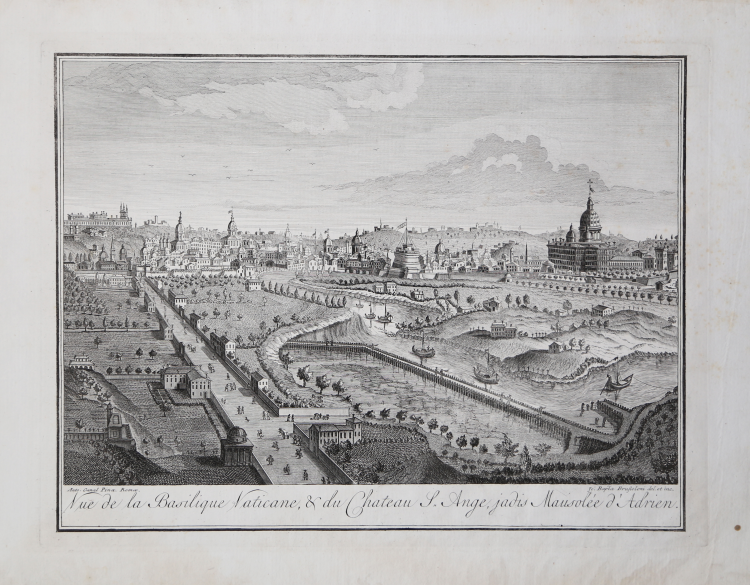



| Reference: | S21464 |
| Author | Giambattista BRUSTOLON |
| Year: | 1770 |
| Measures: | 380 x 285 mm |


| Reference: | S21464 |
| Author | Giambattista BRUSTOLON |
| Year: | 1770 |
| Measures: | 380 x 285 mm |
View of the Tiber and Rome from the Basilica of St Valentino on the Via Flaminia
Etching and engraving, signed on lower right plate.
After a drawing of Canaletto, today at the British Museum [1858,0626.221].
Magnificent work, printed on contemporary laid paper with wide margins, in perfect condition.
The Correr Museum owns a collection of fifteen sheets depicting views of Rome engraved by Brustolon after drawings of Canaletto; the front page, handwritten, bears the inscription Vari Prospetti di Roma Antica e Moderna.
The 1817 catalogue of the typography of Remondini lists 15 “Roman” subjects; nonetheless, according to Meschini, Brustolon’s views of Rome are not less than twenty five.
Very rare.
|
Succi, Da Carlevarijs ai Tiepolo, p. 82; Maria Catelli Isola, in "I ponti di Roma" (1975): p. 76, n. 120; Roma Veduta (2000): pp. 181-182, n. 37 (variante).
|
Giambattista BRUSTOLON (Venezia 1716 – 1796)
|
Italian printmaker. His family was from Belluno. He studied with Josef [Giuseppe] Wagner (1706–80). An able reproductive engraver, Brustolon mostly employed a technique that combined etching and engraving, and his work was done for the best Venetian publishers. He is known mainly for his reproductive prints after works by Canaletto. In 1763, for the publisher Ludovico Furlanetto, Brustolon produced a series entitled Prospectuum aedium, viarumque insigniorum urbis Venetiarum, dedicated to the Doge Marco Foscarini and initially composed of 12 views of Venice after Canaletto. It was later completed by the addition of 10 more plates after Michele Giovanni Marieschi and Giambattista Moretti in addition to further plates after Canaletto. Brustolon’s most famous series, also published by Furlanetto, was Feste dogali, featuring 12 large engravings of ceremonies and festivals attended by the Doge, derived from drawings by Canaletto. Around 1779 Brustolon started working on a series of 24 architectural capriccios after Canaletto, which was never completed. On 29 September 1780 he asked for the exclusive rights to make a series of 22 prints representing views of Rome, the original drawings of which had been given to him by Canaletto’s heirs. The most complete series is in the library of the Correr Museum, Venice, entitled Varii prospetti di Roma antica e moderna. Apart from reproductive prints, Brustolon also engraved book illustrations, as for example the plates in Antonio Francesco Gori’s Dactyliotheca Smithiana (Venice, 1767), a two-volume catalogue of the gem collection of Consul Joseph Smith, published by Giambattista Pasquali.
|
|
Succi, Da Carlevarijs ai Tiepolo, p. 82; Maria Catelli Isola, in "I ponti di Roma" (1975): p. 76, n. 120; Roma Veduta (2000): pp. 181-182, n. 37 (variante).
|
Giambattista BRUSTOLON (Venezia 1716 – 1796)
|
Italian printmaker. His family was from Belluno. He studied with Josef [Giuseppe] Wagner (1706–80). An able reproductive engraver, Brustolon mostly employed a technique that combined etching and engraving, and his work was done for the best Venetian publishers. He is known mainly for his reproductive prints after works by Canaletto. In 1763, for the publisher Ludovico Furlanetto, Brustolon produced a series entitled Prospectuum aedium, viarumque insigniorum urbis Venetiarum, dedicated to the Doge Marco Foscarini and initially composed of 12 views of Venice after Canaletto. It was later completed by the addition of 10 more plates after Michele Giovanni Marieschi and Giambattista Moretti in addition to further plates after Canaletto. Brustolon’s most famous series, also published by Furlanetto, was Feste dogali, featuring 12 large engravings of ceremonies and festivals attended by the Doge, derived from drawings by Canaletto. Around 1779 Brustolon started working on a series of 24 architectural capriccios after Canaletto, which was never completed. On 29 September 1780 he asked for the exclusive rights to make a series of 22 prints representing views of Rome, the original drawings of which had been given to him by Canaletto’s heirs. The most complete series is in the library of the Correr Museum, Venice, entitled Varii prospetti di Roma antica e moderna. Apart from reproductive prints, Brustolon also engraved book illustrations, as for example the plates in Antonio Francesco Gori’s Dactyliotheca Smithiana (Venice, 1767), a two-volume catalogue of the gem collection of Consul Joseph Smith, published by Giambattista Pasquali.
|